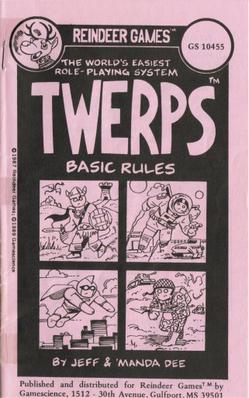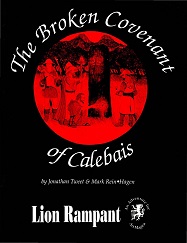
TWERPS is a minimalist role-playing game (RPG) originally created by Reindeer Games in 1987 and distributed by Gamescience. Presented as a parody of the complicated RPG systems which were prevalent at the time while still being a playable game in its own right, its simple structure and humorous nature gave it unexpected popularity.

The Dungeon Master's Guide is a book of rules for the fantasy role-playing game Dungeons & Dragons. The Dungeon Master's Guide contains rules concerning the arbitration and administration of a game, and is intended for use by the game's Dungeon Master.

DC Heroes is an out-of-print superhero role-playing game set in the DC Universe and published by Mayfair Games. Other than sharing the same licensed setting, DC Heroes is unrelated to the West End Games DC Universe or the more recent Green Ronin Publishing DC Adventures game.

The Complete Fighter's Handbook is a supplemental rulebook published in December 1989 for the 2nd edition of the Advanced Dungeons & Dragons fantasy role-playing game. Accompanying manuals are The Complete Thief's Handbook, Priest's Handbook, and Wizard's Handbook.

The Complete Thief's Handbook is a supplemental rulebook published in 1989 for the 2nd edition of the Advanced Dungeons & Dragons fantasy role-playing game. Accompanying manuals are The Complete Fighter's Handbook, Priest's Handbook, and Wizard's Handbook.

The Complete Priest's Handbook is a supplemental rulebook published in 1990 for the 2nd edition of the Advanced Dungeons & Dragons fantasy role-playing game. Accompanying manuals are The Complete Fighter's Handbook, Thief's Handbook, and Wizard's Handbook.

The Complete Wizard's Handbook is a supplementary rulebook published in 1990 for the 2nd edition of the Advanced Dungeons & Dragons fantasy role-playing game. Accompanying manuals are The Complete Fighter's Handbook, Priest's Handbook, and Thief's Handbook.

Ravenloft: Realm of Terror is a boxed set accessory published in 1990 for the Ravenloft campaign setting for the Advanced Dungeons & Dragons fantasy role-playing game.

Hidden Kingdom is a role-playing game published by New Rules Inc. in 1985.

MEGA Role-Playing System, Fantasy Edition is a Norwegian role-playing game published by MEGA Games Ltd. (U.K.) in 1987.

Omnigon is a role-playing game published by Omnigon Games Inc. in 1989.

Eternal Soldier is a set of rules for role-playing game combat that was published by Tai-Gear Simulations in 1986.
The Talislantan Handbook is a supplement published by Bard Games in 1987 for the fantasy role-playing game Talislanta.

The Broken Covenant of Calebais is an adventure published by Lion Rampant in 1988 for the fantasy role-playing game Ars Magica.

Barony, subtitled "Fantasy Role-Play", is a role-playing game published by Better Games in 1990.

Covenants is a supplement published by White Wolf Publishing in 1990 for the fantasy role-playing game Ars Magica.

Legendary Lives Player's Primer is the first of two books published by Marquee Press in 1990 required for the role-playing game Legendary Lives.

Legendary Lives Referee's Rulebook is one of the two books published by Marquee Press in 1990 required for the role-playing game Legendary Lives.

Shields of Power is a fantasy role-playing game published by Shield Maiden in 1990.

Era Ten, subtitled "Sci Fi Role-Play", is a science fiction role-playing game (RPG) published by Better Games in 1990.



















